India Rooftop Solar Market Size
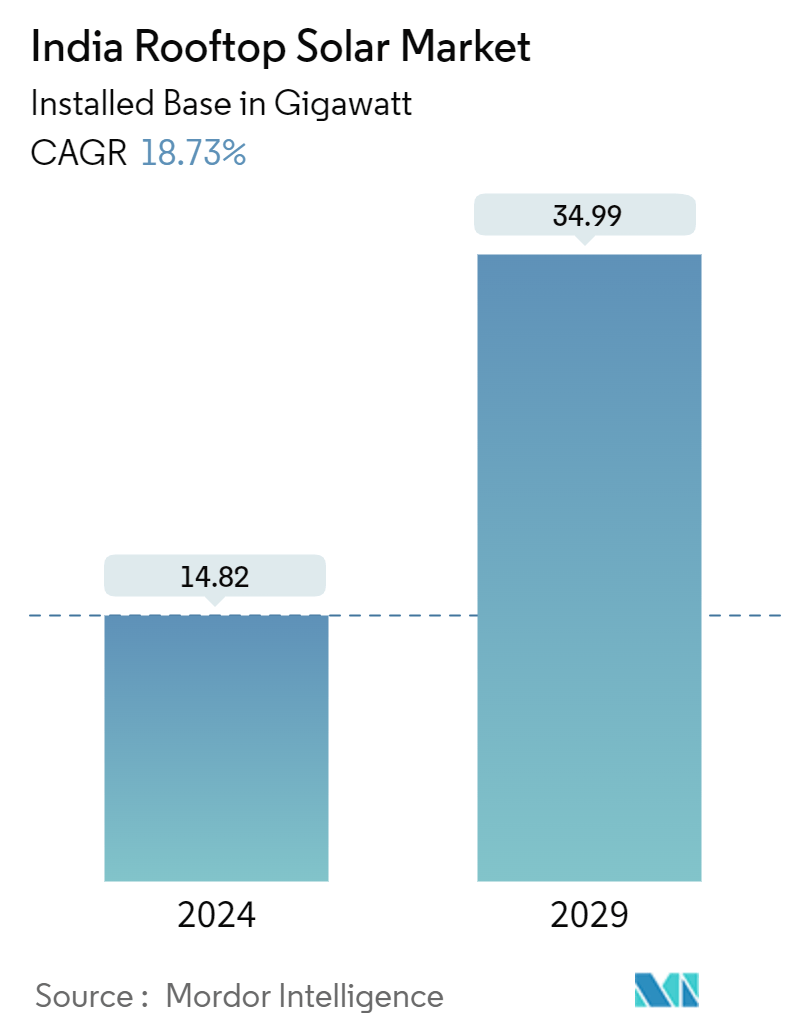
| Study Period | 2019 - 2029 |
| Base Year For Estimation | 2023 |
| Forecast Data Period | 2024 - 2029 |
| Historical Data Period | 2019 - 2022 |
| CAGR (2024 - 2029) | 18.73 % |
| Market Concentration | Low |
Major Players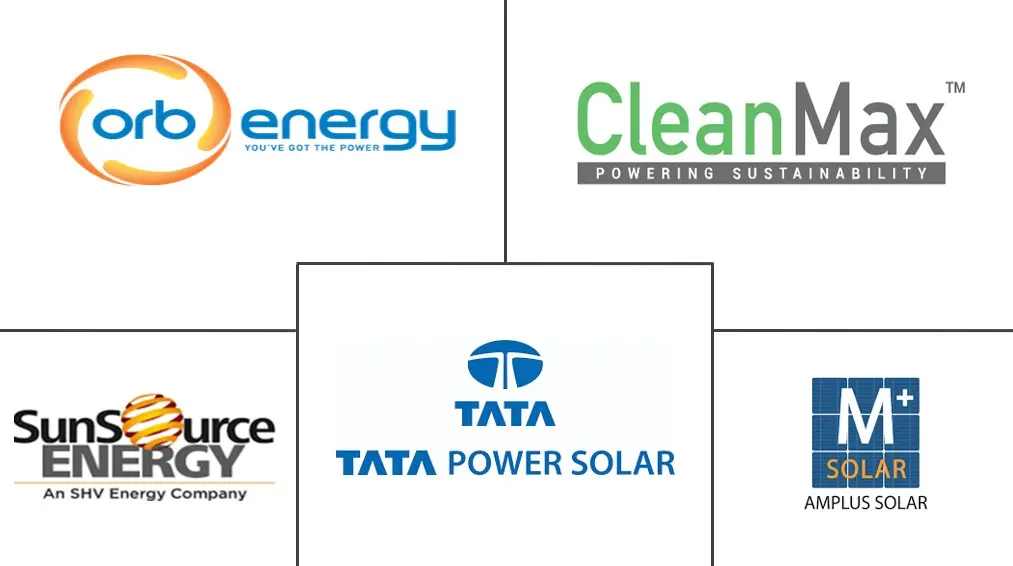
*Disclaimer: Major Players sorted in no particular order |
India Rooftop Solar Market Analysis
The India Rooftop Solar Market size in terms of installed base is expected to grow from 14.82 gigawatt in 2024 to 34.99 gigawatt by 2029, at a CAGR of 18.73% during the forecast period (2024-2029).
- Over the long term, factors such as increasing demand in the commercial and industrial sectors and government emphasis on renewable energy integration are expected to be significant drivers for the market’s growth.
- On the other hand, slow-paced installation of rooftop projects may likely restrain the growth of the Indian rooftop solar market over the coming years.
- Nevertheless, the untapped solar potential and focus on increasing decentralization would enable residential and industrial customers to rely less on central grids, which is expected to be a growth opportunity during the forecast period.
India Rooftop Solar Market Trends
The On-grid Segment is Expected to Dominate the Market
- In the on-grid rooftop system, photovoltaic panels or arrays are connected to the utility grid through a power inverter unit, allowing them to operate in parallel with the electric utility grid. The electricity generated by consumers is fed into the central power grid through a net-metering scheme. Such kind of connection is commonly used by commercial, industrial, and residential consumers to reduce electricity bills.
- In India, on-grid or grid-connected solar PV systems have witnessed significant growth in recent years owing to the various government policies and initiatives. This is likely to support the country in achieving its 2030 national renewable energy target.
- The country introduced the Grid Connected Solar Rooftop Scheme to promote solar rooftop installation by the state and central government. India aims to achieve a cumulative installed capacity of about 40,000 MW from Grid Connected Rooftop solar projects by the end of March 2026.
- For instance, the Ministry of New and Renewable Energy launched the Rooftop Solar Programme Phase-II scheme in March 2019 to reach the set targets. Under the scheme, the ministry is expected to provide consumers with Central Financial Assistance (CFA) for installing Rooftop Solar (RTS) in individual households or Resident Welfare Associations/Group Housing Societies.
- In September 2023, the National Portal was launched to ease the online process for consumers to install RTS. Residential consumers from any part of the country are eligible to apply for the installation of rooftop solar panels and receive a subsidy directly in their bank accounts.
- According to the Ministry of New and Renewable Energy (MNRE), during the 2023-2024 period, the cumulative solar rooftop installed capacity connected to the grid reached 11.8 GW, representing an increase of 33.86% from 8.9 GW in the 2022-2023 period. Several large-scale solar energy projects were operational and connected to the grid during 2023, which was majorly responsible for the sharp increase in the installed capacity.
- Gujarat, Maharashtra, and Karnataka are the states with the highest on-grid rooftop solar PV installed capacity. Until March 2024, Gujarat generated 3.45 GW, while Karnataka and Rajasthan generated around 7.9 GW and 1.15 GW, respectively.
- Overall, factors including the increasing adoption of rooftop solar energy for power generation, government support in the form of supportive policies, schemes, and ambitious renewable targets are expected to witness significant growth of the on-grid segment in the Indian solar rooftop market during the forecast period.
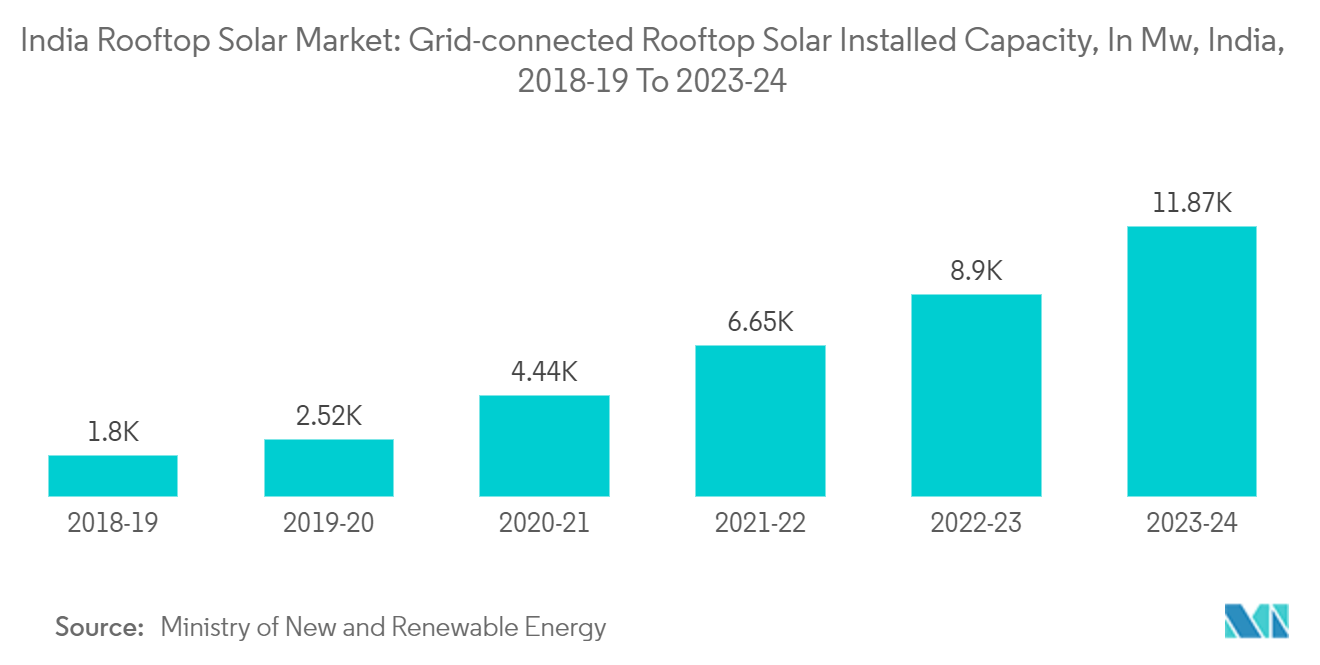
Government Emphasis on Renewable Energy Integration is Expected to Drive the Market
- According to the Ministry of New and Renewable Energy (MNRE), India secured the fifth position globally in the deployment of solar power. As of June 30, 2023, the country commissioned solar projects with a total capacity of 70.10 GW. This capacity comprised 57.22 GW from ground-mounted solar projects, 10.37 GW from rooftop solar projects, and 2.51 GW from off-grid solar projects.
- As of March 2023, the rooftop solar capacity increased to 8,877 MW, compared to 7,520 MW as of September 30, 2022. The primary factors attributed to this growth included heightened awareness among residential consumers and government subsidies targeted toward the residential segment.
- The government has formulated comprehensive policies and regulations to support rooftop solar deployment. The government took several net metering initiatives, which allow rooftop solar users to sell excess electricity generated back to the grid, providing financial benefits and promoting grid stability.
- For instance, in March 2024, the Rajasthan Electricity Regulatory Commission (RERC) raised the limit for net metering from 500 kW to 1 MW for rooftop solar installations. The Commission's decision, made through a suo motu order, aims to promote the adoption of rooftop solar installations by expanding the net metering capacity.
- Further, in November 2023, the Tamil Nadu Electricity Regulatory Commission (TNERC) issued a new order endorsing the state government's directive to exempt 50% of network charges for rooftop solar consumers in the MSME sector.
- As of March 2023, the MNRE quoted that about 404 MW of rooftop solar capacity was installed against the target of 357.9 MW up to January 2023, a decline from 678 MW since the previous financial year.
- In August 2023, the Maharashtra Electricity Regulatory Commission proposed amendments in regulations to increase the capping of net metering to 1 MW for solar rooftop projects. The net-metering applicability stood around 500 kW for rooftop solar plants in most Indian states as mandated by MNRE. The approval of proposed amendments might lead to an increase in the adoption of rooftop solar projects by large consumers. This might benefit the development of the solar rooftop market in India.
- These government incentives usually include subsidies, tax credits, grants and loan programs, and additional green credits. The Indian government is rolling out new fiscally attractive incentive schemes for residential, commercial, and industrial (C&I) solar PV systems. This will likely drive the market during the forecast period.
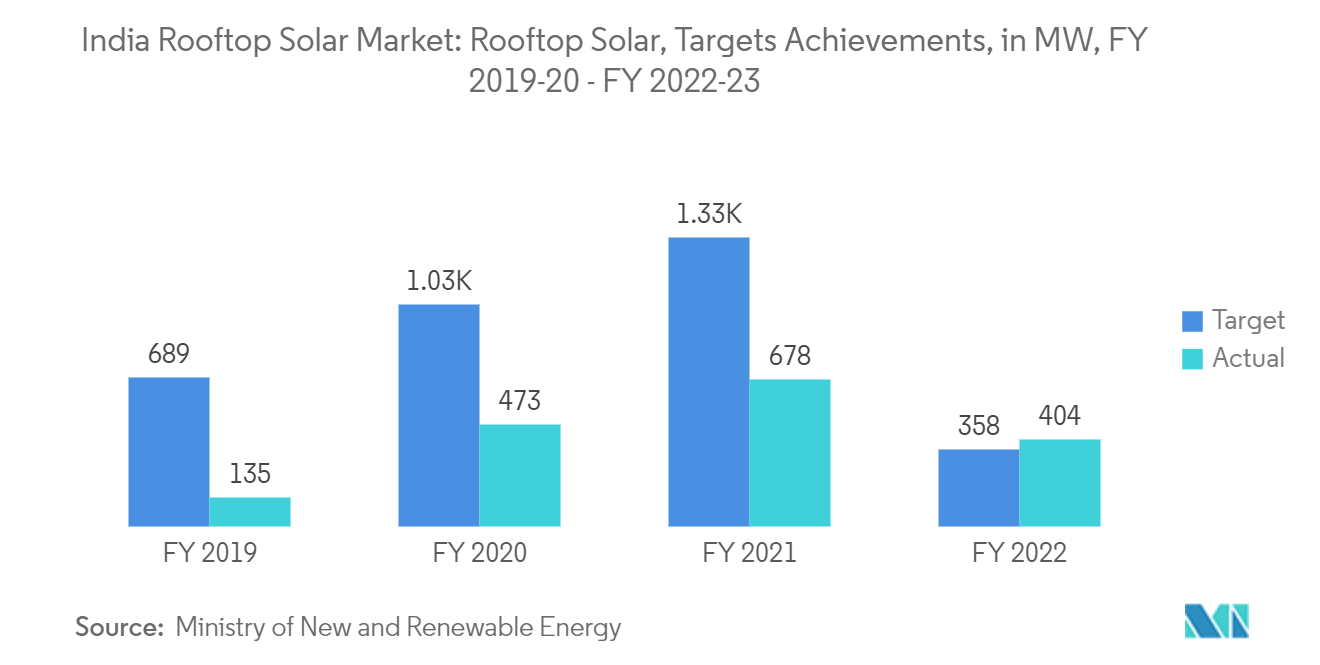
India Rooftop Solar Industry Overview
The Indian rooftop solar market is fragmented. Some key players in this market include Clean Max Enviro Energy Solutions Pvt. Ltd, Tata Power Solar Systems Limited, Orb Energy Pvt. Ltd, Amplus Solar Power Private Limited, and Sunsource Energy Pvt. Ltd.
India Rooftop Solar Market Leaders
-
Tata Power Solar Systems Limited
-
Amplus Solar Power Private Limited
-
Clean Max Enviro Energy Solutions Pvt. Ltd
-
Orb Energy Pvt. Ltd
-
Sunsource Energy Pvt. Ltd
*Disclaimer: Major Players sorted in no particular order
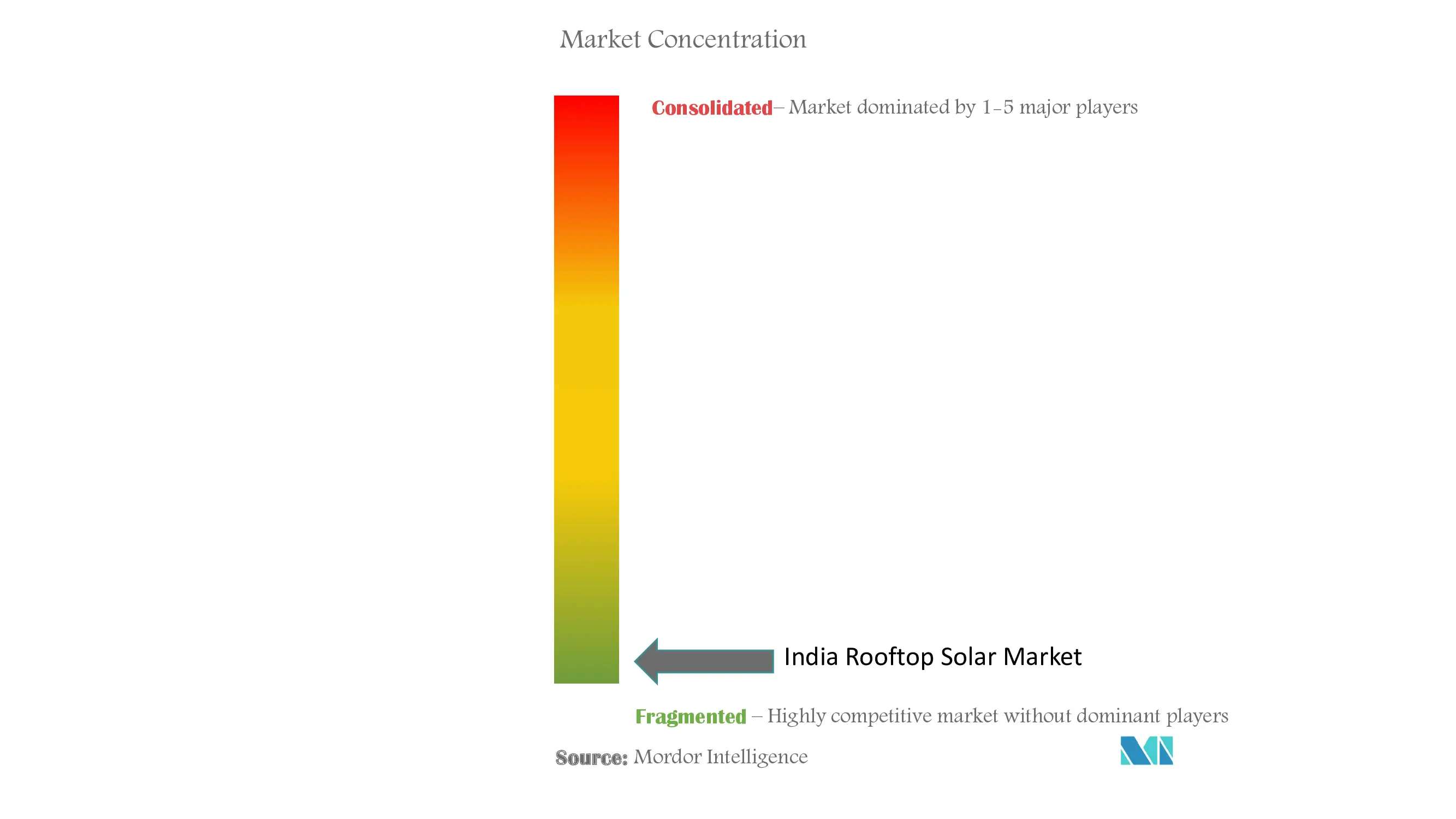
India Rooftop Solar Market News
- April 2024: Apple announced forming a joint venture with renewable energy developer CleanMax to invest in six rooftop solar projects to power its operations in India. The solar project is expected to have a total capacity of 14.4 MW and, when operational, will provide a local solution to power the company’s offices and two retail stores in Mumbai and New Delhi.
- March 2024: GAIL (India) announced an invitation for bids regarding a rooftop solar project. This project is expected to involve designing, supplying, installing, testing, and commissioning a grid-tied rooftop solar PV (photovoltaic) system. Additionally, this initiative includes a comprehensive 5-year Annual Maintenance Contract (AMC) to supply electricity generated by the project to the Krishna Godavari Basin area.
India Rooftop Solar Market Report - Table of Contents
1. INTRODUCTION
- 1.1 Scope of the Study
- 1.2 Market Definition
- 1.3 Study Assumptions
2. EXECUTIVE SUMMARY
3. RESEARCH METHODOLOGY
4. MARKET OVERVIEW
- 4.1 Introduction
- 4.2 Market Size and Demand Forecast, till 2029
- 4.3 Recent Trends and Developments
- 4.4 Government Policies and Regulations
-
4.5 Market Dynamics
- 4.5.1 Drivers
- 4.5.1.1 Government Emphasis Towards Renewable Energy Integration
- 4.5.1.2 Increasing Demand in the Commercial and Industrial Sector
- 4.5.2 Restraints
- 4.5.2.1 Slow-Paced Installation of Rooftop Projects
- 4.6 Supply Chain Analysis
- 4.7 PESTLE Analysis
5. MARKET SEGMENTATION
-
5.1 End-user
- 5.1.1 Industrial
- 5.1.2 Commercial (Including Public Sector)
- 5.1.3 Residential
-
5.2 Grid Type (Qualitative Analysis Only)
- 5.2.1 On-grid
- 5.2.2 Off-grid
6. COMPETITIVE LANDSCAPE
- 6.1 Mergers and Acquisitions, Joint Ventures, Collaborations, and Agreements
- 6.2 Strategies Adopted by Leading Players
-
6.3 Company Profiles
- 6.3.1 Cleantech Energy Corporation Pte Ltd
- 6.3.2 Fourth Partner Energy Pvt. Ltd
- 6.3.3 Amplus Solar Power Pvt. Ltd
- 6.3.4 Clean Max Enviro Energy Solutions Pvt. Ltd
- 6.3.5 Sunsource Energy Pvt. Ltd
- 6.3.6 Orb Energy Pvt. Ltd.
- 6.3.7 Tata Power Solar Systems Limited
- 6.3.8 Mahindra Susten Pvt. Ltd
- 6.3.9 Growatt New Energy Technology Co. Ltd
- 6.3.10 Roofsol Energy Pvt. Ltd
- *List Not Exhaustive
- 6.4 Market Ranking Analysis
7. MARKET OPPORTUNITIES AND FUTURE TRENDS
- 7.1 Untapped Solar Potential and Focus to Increase Decentralization
India Rooftop Solar Industry Segmentation
Rooftop solar PV is a photovoltaic system with electricity-generating solar panels mounted on the rooftop of a commercial or residential building. It captures the sun's energy and converts it into electrical energy.
The Indian rooftop solar market is segmented by end user and grid type. By end user, the market is segmented into commercial, industrial, and residential. By grid type, the market is segmented into on-grid and off-grid. For each segment, the market sizing and forecasts were made based on installed capacity.
| End-user | Industrial |
| Commercial (Including Public Sector) | |
| Residential | |
| Grid Type (Qualitative Analysis Only) | On-grid |
| Off-grid |
India Rooftop Solar Market Research FAQs
How big is the India Rooftop Solar Market?
The India Rooftop Solar Market size is expected to reach 14.82 gigawatt in 2024 and grow at a CAGR of 18.73% to reach 34.99 gigawatt by 2029.
What is the current India Rooftop Solar Market size?
In 2024, the India Rooftop Solar Market size is expected to reach 14.82 gigawatt.
Who are the key players in India Rooftop Solar Market?
Tata Power Solar Systems Limited, Amplus Solar Power Private Limited, Clean Max Enviro Energy Solutions Pvt. Ltd, Orb Energy Pvt. Ltd and Sunsource Energy Pvt. Ltd are the major companies operating in the India Rooftop Solar Market.
What years does this India Rooftop Solar Market cover, and what was the market size in 2023?
In 2023, the India Rooftop Solar Market size was estimated at 12.04 gigawatt. The report covers the India Rooftop Solar Market historical market size for years: 2019, 2020, 2021, 2022 and 2023. The report also forecasts the India Rooftop Solar Market size for years: 2024, 2025, 2026, 2027, 2028 and 2029.
What are the key trends in the India Solar Rooftop Market?
The key trends in the India Solar Rooftop Market are a) Technological advancements: increased efficiency, energy storage, smart systems and building-integrated photovoltaics b) Growth in the commercial and industrial sectors: cost savings and CSR initiatives
India Rooftop Solar Industry Report
The India Solar Rooftop Market is experiencing significant growth, driven by the increasing need for renewable energy solutions and supportive government policies. This market, including the residential rooftop solar market in India, is segmented based on connectivity, with the on-grid segment dominating due to its ability to feed surplus energy back into the electrical grid, supported by incentives like net metering and feed-in tariffs. The commercial segment leads the rooftop solar market size in India, propelled by cost savings, government incentives, and corporate sustainability goals. South India, with its high solar irradiation levels and progressive policies, is a major contributor to the rooftop solar market in India. Challenges such as regulatory hurdles, financing issues, and grid integration complexities persist, but innovative business models and technological advancements are paving the way for broader adoption. Overall, the market is set to continue its upward trajectory, bolstered by declining solar panel costs and a growing emphasis on sustainable energy practices across various sectors. For detailed statistics on the India Rooftop Solar market share, size, and revenue growth rate, refer to Mordor Intelligence™ Industry Reports, which include a market forecast outlook and historical overview. Get a sample of this industry analysis as a free report PDF download.



